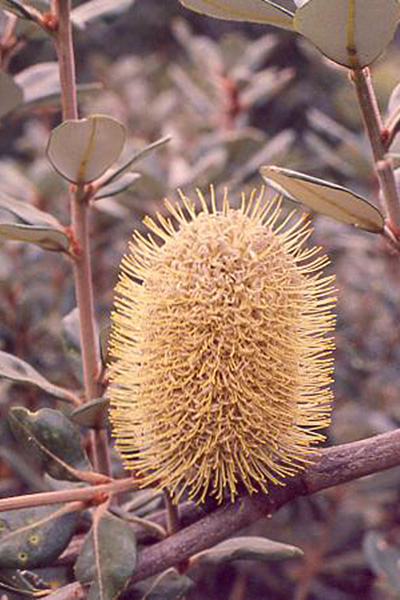General Description:
Known as the Mt William form of Banksia integrifolia for some years, Banksia saxicola was officially described by Alex George in 1981 in his revision of the genus Banksia. It is known as the Grampians banksia or Mount William banksia, yet neither name takes into account that it also occurs in Wilsons Promontory, hundreds of kilometres to the east, thus Rock banksia is possibly a more apt common name. At the latter location it grows alongside Banksia integrifolia without interbreeding. Interestingly, a suckering plant and presumptive hybrid with B.marginata has been found in the Grampians.
In habit, B.saxicola ranges from a bushy, low-branching shrub to 2 metres or as a small, spreading tree to 5 metres in exposed areas in the Grampians (or up to 10 m in the gullies there), to a taller tree-like plant to 15 metres at Wilsons Promontory (where it is rare and in decline). A feature of the plant is the attractive dark green shiny obovate leaves, which are up to 10-14 cm long and 3.5 cm wide, with a white undersurface. Flowering occurs in summer through to early autumn, with grey-yellow flowered spikes to 9 cm long and 6 cm wide. Old cones have seed pods which remain closed until burnt.
The Rock banksia is non-lignotuberous and regenerates from seed after fire. Though there is some evidence of interfire regeneration in the Grampians, the Wilsons Promontory population at Sealers Cove has not been burnt since 1951 and many of the plants are growing old with no new seedlings. However, Jim Whelan (Parks Victoria Ranger at Wilsons Promontory National Park) notes that there is a second population of the species (on the north side of 5 Mile Peak) in Wilsons Promontory National Park about 7 km north of the Sealers Cove colony, which may have been burnt in 1967. The area is inaccessible except by foot and it would be difficult to carry out a controlled burn there. However, the Parks Service is developing a management plan for burning within the Park.
To date Banksia saxicola has been mainly cultivated in cool climates, where it has proven adaptable to both light and heavier (clay) soils. Plants grown in warmer, frost free climates in New South Wales have been very reluctant to flower.
Propagation from seed is relatively easy, however, there is no guarantee that seed from a shrubby form will not grow into a tree, especially in a more protected environment.
* EPBC Act = Environment Protection and Biodiversity Conservation Act 1999;
ROTAP = Rare or Threatened Australian Plants (Briggs and Leigh, 1988)
For further information refer the Australian Plants at Risk page

Flower spike of Banksia saxicola
Photo: Brian Walters

Seed cone of Banksia saxicola
Photo: Cas Liber
 Australian Native Plants Society (Australia)
Australian Native Plants Society (Australia)